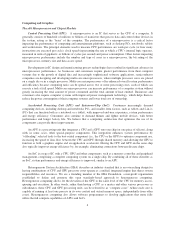AMD 2014 Annual Report Download - page 12
Download and view the complete annual report
Please find page 12 of the 2014 AMD annual report below. You can navigate through the pages in the report by either clicking on the pages listed below, or by using the keyword search tool below to find specific information within the annual report.primarily of performance AMD A-Series APUs and AMD E-Series APUs. These APUs combine discrete-level
AMD Radeon™ graphics, dedicated HD video processing and multi-core CPU processors on a single chip and
are designed to maximize performance and energy efficiency. In April 2014, we announced our 2014 mainstream
and low-power APUs and mobile APUs, formerly codenamed “Beema” and “Mullins,” respectively, which
feature up to four newly-designed x86 CPU cores with AMD Radeon graphics and a hardware-level data security
solution based on the ARM®Cortex®-A5, all on a single SoC. In June 2014, we introduced our 2014
Performance Mobile APUs, formerly codenamed “Kaveri,” designed for ultrathin and high-performance mobile
PCs. As part of the 2014 Performance Mobile APUs, we introduced the AMD FX APU designed for enthusiast-
level performance for gaming and multitasking. Also, in June 2014, we announced our new AMD Pro A-Series
APUs with HSA features designed for commercial notebook PCs.
Chipsets. Our portfolio of chipset products includes chipsets with and without IGPs for desktop and
notebook PCs and servers, as well as AMD Controller Hub-based chipsets for our APUs. We offer AMD
9-Series and AMD A88X, A85X, A78, A75, A68H, A58 and A55 for desktop PCs, and we offer AMD A76M
chipsets for notebook PCs. We also offer AMD 785E, SR5690, 780E and M690T chipsets for our embedded
products.
Graphics Market
The semiconductor graphics market addresses the need for improved visual processing in various computing
devices. Many consumers value a rich visual experience to enable a more compelling and immersive experience,
and, for these consumers, the PC is evolving from a traditional data processing and communications device to an
entertainment platform. As a result, visual realism and graphical display capabilities are key product
differentiation elements among computing devices. This has led to increasing creation and use of processing-
intensive multimedia content for computing devices, including playing games, capturing TV and other
multimedia content, viewing online videos, photo editing and managing digital content. In turn, these trends have
contributed to higher consumer demand for performance graphics solutions and manufacturers designing
computing devices with these capabilities.
Our APUs deliver visual processing functionality for value and mainstream PCs by integrating a CPU and a
GPU on a single chip, while discrete GPUs (which are also known as dedicated GPUs) are on a separate chip
from the CPU and are specifically architected for higher performance graphics processing. Heavy computational
workloads have traditionally been processed on a CPU, but we believe that the industry is shifting to a new
computing paradigm that increasingly relies more on a discrete GPU or an APU. AMD Accelerated Parallel
Processing or GPGPU (General Purpose GPU) refers to a set of advanced hardware and software technologies
that enable discrete AMD GPUs, working in concert with the CPU, to accelerate applications beyond traditional
graphics and video processing by allowing the discrete GPU and the CPU to process information cooperatively.
In addition, computing devices with HSA features run computationally-intensive tasks more efficiently, which
we believe provides a superior application experience to the end user.
Our Graphics Products
Our graphics products can be found in an APU, GPU, SoC or a combination of a GPU with one of the other
foregoing products working in tandem. Our customers generally use our graphics solutions to increase the speed
of rendering images and to help improve image resolution and color definition. We develop our graphics
products for use in various computing devices and entertainment platforms, including desktop PCs, notebook
PCs, 2-in-1s and professional workstations. With each of our graphics products, we have available drivers and
supporting software packages that enable the effective use of these products under a variety of operating systems
and applications. In addition, our recent generation graphics products have Linux®driver support.
Discrete Desktop Graphics. We offer discrete graphics products for gaming, multimedia, editing photos
and videos as well as other graphic-intensive applications on desktop platforms. Our discrete GPUs for desktop
6
























